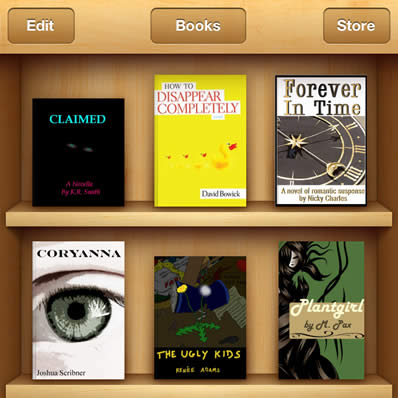This is a guest post by Payman Taei.
In nearly every aspect of your business, visual communication and the principles of storytelling have a very important role to play. Whether you’re doing something as simple as putting an attractive-looking video on a landing page in an effort to increase conversions or you’re making boring data and stats come alive by way of a compelling Infographic, human beings are visual learners and this is absolutely something you can use to your advantage.
However, one format that many believes tests this theory is also one of the more modern – the e-book. For a traditional book to be taken seriously, it usually has to rely heavily (and primarily) on straight text, right? This is just the approach that your audience is looking for when they pick this format over something more inherently visual like a presentation, right? If all that is accepted as fact, the same MUST be true of the e-book – after all, it’s little more than a digital copy of something that exists in hard copy, right?
For the record, the answers to those previous three questions are “wrong,” “wrong” and “very, very wrong.”

Visual Communication and E-Books:
A Match Made in Heaven
E-Books: By the Numbers
To say that e-books in general have become incredibly popular over the last few years is something of an understatement. Spawned both by the smartphone revolution and the increased prominence of mobile devices like tablets, e-books have become a major part of the lives of many.
According to one study, for example, e-book sales currently make up over 12% of total book sales worldwide – a number that sees a significant increase every year. Approximately 28.9 million e-book readers (both dedicated readers like Kindles or tablets that can also read e-books like the iPad) were shipped last year.
While it’s true that digital copies of fiction books from major publishers make up a huge portion of sales, this is only one small part of a much larger story. Estimates put consumer and educational e-book publishing revenue – meaning the category that you would fall into if you started creating and selling e-books for your business – at roughly $14.55 billion worldwide.
“According to one study, e-book sales currently make up over 12% of total book sales worldwide.”
The Major Benefits of E-Books
One of the major benefits that the e-book format brings to the table for businesses in particular is versatility. It can essentially be anything you need it to be, whenever you need it.
If you want to take that 300 page book that your company produced that has fallen out of print and quickly get it back into circulation online, you can do so by creating a straight copy of the original text. However, if you’ve got about 30 pages worth of content that you ALSO want to make available in a flexible format, e-books are great for that, too.
E-books can even be a great way to collect all of the helpful blog posts that you’ve written for your website into one larger document, giving that content a brand new life to people who may be interested but who couldn’t be bothered to read the blog itself. How you choose to create your e-book can vary wildly depending on exactly what you’re trying to accomplish.
Another major benefit of the e-book format is that they can be read on nearly any device a consumer may have. Smartphones like the iPhone come with e-book reading software built right in – in Apple’s case, it’s the iBooks application. Some e-book formats are even compatible with most major Web browsers.
The king of the e-book reader empire – Amazon – has even made a free version of its Kindle software available for both MacOS and Windows computers. If you’re married to using an e-book specific format like EPUB, a user won’t have to pay a dime to get that book opened on their computer in seconds.
Visual Communication and E-Books: A Match Made in Heaven
The fact of the matter is that the only way the argument that visual communication has no place in an e-book actually makes sense is if you pay more attention to the “book” part of the term than you do the “E.”
Again – the e-book format is versatile enough to be anything you want it to be given what you’re trying to accomplish. If your only goal is to take a book that you’ve already published and create a digital copy of it, yes – it stands to reason that the finished product would be mostly text.
But at the same time, there’s nothing to stop you from pushing the format to its limit and creating the type of rich multi-media experience users won’t be able to find anywhere else.
It can be helpful to think of e-books as something of a container format – they’re an opportunity to bring together all of the visual content you’ve already been creating into a single source for your end users.
Say you’ve spent time creating a professional presentation with a tool like Visme, for example. It works great on its own, but it needs a bit more meat on its bones to really justify the jump into the e-book format. You can easily use the presentation as a framework and build out from there – adding things like Infographics, audio clips, visuals and text-based pieces to provide more context and to create something richer and more fulfilling than any one of these elements would have been able to accomplish on their own.
For an example of this idea in motion, consider the most recent book from filmmaker Kevin Smith – writer and director of movies like “Clerks” and “Dogma.” Each chapter of the e-book contains all of the text from the hard copy of the book, but also included are motion graphics and even video clips of the director expanding on some of the topics being discussed in the text proper.
Readers of the text still get all of the same information, but e-book readers get something a little more unique – something that takes the traditional book experience and really elevates it into something more modern.

Unlocking the Potential of E-Books.
Visual communication has an essential role to play in e-book development, regardless of the topic or the audience you’re trying to reach.
Unlocking the Potential of E-Books
This is just one of the many examples of innovative things that you can do when creating content for your business by way of an e-book – but only if you’re willing to expand what you know about the format in the first place. It’s also a clear example of why visual communication has an essential role to play in e-book development, regardless of the topic or the audience you’re trying to reach.
Don’t just think of e-books as “electronic books” in that they’re a digital recreation of an experience we’ve been having as a society for hundreds of years. Think of them as the natural evolution of that experience. They can and should be something more, starting with the foundation of what it means to write a book and creating something much more interesting from there.
About the Author
Payman Taei is the founder of Visme, an easy-to-use online tool to create engaging presentations, infographics, and other forms of visual content. He is also the founder of HindSite Interactive, an award-winning Maryland based digital agency specializing in website design, user experience and web app development.
Interested in videos created exclusively for bookworms?
Watch videos about books, reading and writing. Expect weird, amazing, never known before facts and many more.



